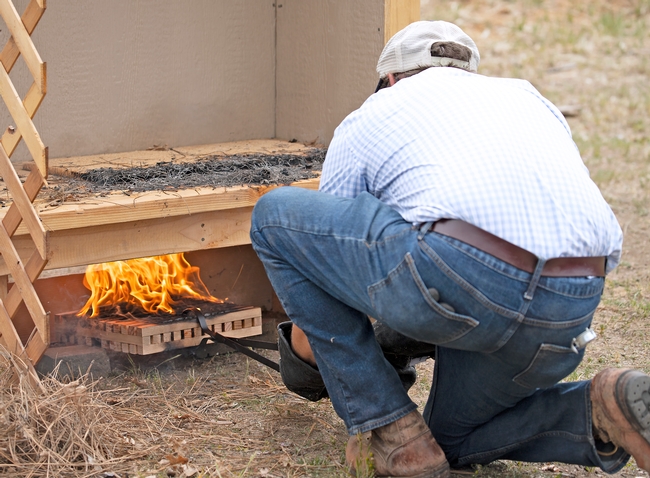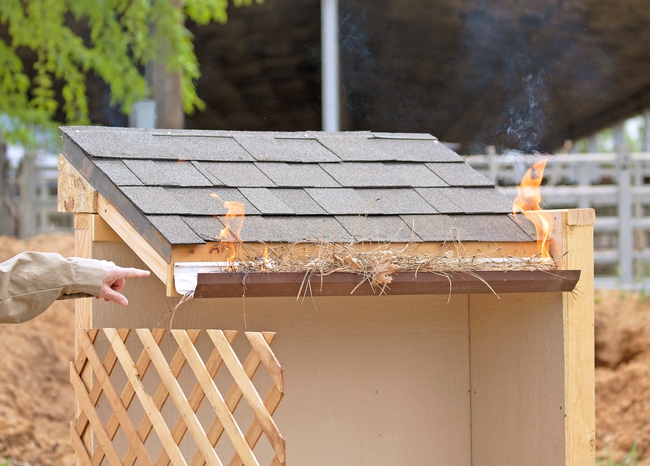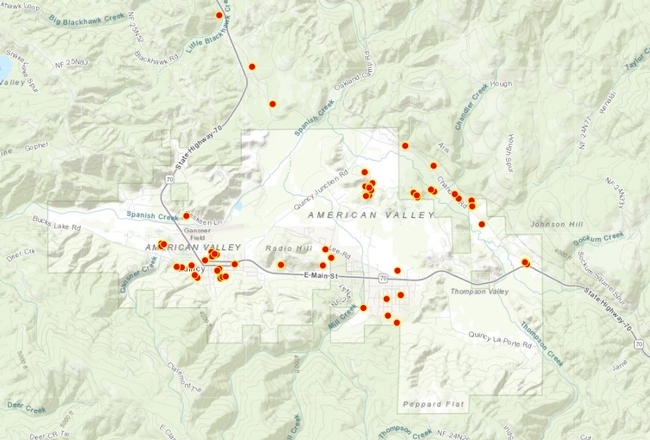Wildfires are becoming more frequent, more intense and more destructive in California. While there are several steps that residents can take to reduce wildfire risk – including maintaining defensible space, hardening homes and evacuation planning – their collective efforts can be more effective on a community scale, says a University of California Cooperative Extension advisor.
“Californians can collaborate and motivate each other to prepare for wildfire,” said Ryan Tompkins, UC Cooperative Extension forester and natural resources advisor. “The more neighbors who prepare their property and residences, the safer a community is.”
Tompkins has been working with communities in Plumas and Sierra counties to become more wildfire resilient by participating in the National Fire Protection Association's Firewise Site USA program. This spring the town of Quincy officially celebrated their Firewise Site USA status at a wildfire preparedness event hosted by the Plumas County Fire Safe Council and UC Cooperative Extension.
“Once we began our community outreach, Quincy Firewise rather quickly earned our certification due to the ease of reporting through the online tool,” said Mike Flanigan, co-owner of Flanigan-Leavitt Insurance Agency in Quincy and co-chair of Quincy Firewise Community. “The online tool does greatly expedite the collecting and reporting processes.”
Firewise Site USA requires a community assessment, an action plan based on the assessment, and annual reporting of volunteer hours and financial investment in accepted wildfire preparedness activities. To save lives and property from wildfire, the program is co-sponsored by the USDA Forest Service, the US Department of the Interior, and the National Association of State Foresters.
As part of this effort, Tomkins and Shane Feirer, his colleague in UC Agriculture and Natural Resources' Informatics and Geographic Information System Program, created an online Firewise USA Site reporting tool to help communities track time and money spent on clearing vegetation to maintain defensible space, public wildfire education, and home retrofitting.

“Not only does this help with recording volunteer investments, but communities can see where the work is happening, and which parts of the community may be underserved by wildfire preparedness efforts,” said Tompkins, who developed the tool for Plumas and Sierra counties, which have over 25 Firewise USA sites and continue to add more recognized sites.
Richard Stockton, co-chair of Quincy Firewise Community, is pleased with the convenience of UC Cooperative Extension's electronic reporting tool for Quincy Firewise.
“When we started the discussion of creating one of the largest Firewise communities in the state, we were concerned on how we would have approximately 2,400 households report their time and invested dollars using the current paper Volunteer/In-Kind Tracking Sheet,” said Stockton, who is an agent for State Farm Insurance in Quincy.
“Mike Flanigan and I are self-employed and we talked about having one of our paid employees gather the current paper tracking sheets and then manually input the data for our community,” Stockton said. “We didn't like this idea, but it is what we were willing to do until we found a dedicated volunteer to step up. When Ryan introduced the electronic reporting tool to us, it answered many of our questions on how we were going to print, distribute, gather and then manually enter the paper tracking sheets.”
While the idea of the electronic reporting tool appealed to Stockton, he withheld judgment until he personally tested its usability.
“I initially downloaded the link on my laptop and my smartphone, Stockton said. “I was very pleased that the tool was simple to use on both devices. I was able to easily input my data and upload photos. The tool has proven to be easy to convey to our community members with a high level of accuracy and efficiency. We need to make sure we have safeguards to protect the participants who are reporting and their personal information.”
Making reporting easy encourages more people to participate in Firewise USA sites.
“With the accuracy and efficiencies that Richard mentions, we are well-positioned to realize much more community investment, and at a faster rate than a paper system would provide,” Flanagan said.
Based on the data, in a three-month period residents in Plumas and Sierra counties have reported investing $525,000 in volunteer hours and expenditures on wildfire preparedness.
“This includes over 5,100 volunteer hours and nearly $385,000 of investment in contractor, equipment and home retrofitting materials cost,” Tompkins said. “Not only does this quantify the work rural residents are performing, but it demonstrates the potential impact community efforts could make in wildfire preparedness if given more funding to develop capacity. This is critical for rural, economically diverse counties with very small populations where capacity across community issues is a perennial stretch.”
Tompkins thinks seeing the cumulative results of residents spending their limited time and hard-earned money to improve their community's resilience will encourage more participation.
“Once we have sufficient data to analyze, we will be able to use the tool to pinpoint future areas of our Quincy Firewise community that have been lacking and needs more of our focus and attention,” Stockton said.
“I love the electronic reporting tool and the timing is perfect for us as we work with an extremely large Firewise community.”
The online reporting tool at https://arcg.is/1ebvbL can be modified for use by other communities. For more information about how to prepare for wildfire, visit https://ucanr.edu/sites/fire/Prepare.

